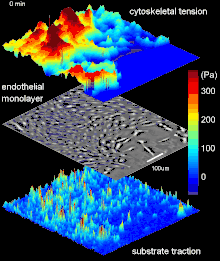Plithotaxis
Plithotaxis, from the Greek word "πλήΘος", denotes a crowd, swarm, or throng. In collective cellular migration, plithotaxis is the tendency for each individual cell within a monolayer to migrate along the local orientation of the maximal principal stress, or equivalently, minimal intercellular shear stress.[1][2][3] Plithotaxis requires force transmission across many cell-cell junctions and therefore is an emergent property of the cell group.

A movie of plithotaxis in action
Plithotaxis is found to hold at the level of both a subcellular grid point and an individual cell of a confluent monolayer, and the stresses must be tensile.[4]
See also
References
- Tambe, D.T., Hardin, C., Angelini, T.E., Rajendran, K., Park, C.Y., Serra-Picamal, X., Zhou, E.H., Zaman, M.H., Butler, J.P., Weitz, D.A., Fredberg JJ, Trepat, X, Collective cell guidance by cooperative intercellular forces. Nature Materials,10(6), 469-475, 2011, doi:10.1038/nmat3025.
- Gov, N. Cell mechanics: Moving under peer pressure. Nature Materials, 10(6), 412-414, 2011, doi:10.1038/nmat3036.
- Trepat, X, Fredberg, JJ. Plithotaxis and emergent dynamics in collective cellular migration. Trends in Cell Biology - 23 July 2011, doi:10.1016/j.tcb.2011.06.006.
- Patel, N.G., Nguyen, A., Xu, N., Ananthasekar, S., Alvarez, D.F., Stevens, T., Tambe, D.T., Unleashing shear: Role of intercellular traction and cellular moments in collective cell migration. Biochemical and Biophysical Research Communications - February 2020, doi:10.1016/j.bbrc.2019.11.048.
This article is issued from Wikipedia. The text is licensed under Creative Commons - Attribution - Sharealike. Additional terms may apply for the media files.